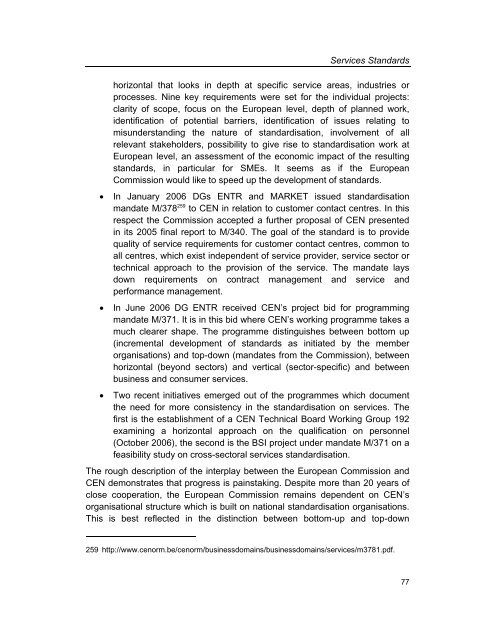Services Standards: Defining the Core Consumer Elements ... - ANEC
Services Standards: Defining the Core Consumer Elements ... - ANEC
Services Standards: Defining the Core Consumer Elements ... - ANEC
Create successful ePaper yourself
Turn your PDF publications into a flip-book with our unique Google optimized e-Paper software.
<strong>Services</strong> <strong>Standards</strong><br />
horizontal that looks in depth at specific service areas, industries or<br />
processes. Nine key requirements were set for <strong>the</strong> individual projects:<br />
clarity of scope, focus on <strong>the</strong> European level, depth of planned work,<br />
identification of potential barriers, identification of issues relating to<br />
misunderstanding <strong>the</strong> nature of standardisation, involvement of all<br />
relevant stakeholders, possibility to give rise to standardisation work at<br />
European level, an assessment of <strong>the</strong> economic impact of <strong>the</strong> resulting<br />
standards, in particular for SMEs. It seems as if <strong>the</strong> European<br />
Commission would like to speed up <strong>the</strong> development of standards.<br />
• In January 2006 DGs ENTR and MARKET issued standardisation<br />
mandate M/378 259 to CEN in relation to customer contact centres. In this<br />
respect <strong>the</strong> Commission accepted a fur<strong>the</strong>r proposal of CEN presented<br />
in its 2005 final report to M/340. The goal of <strong>the</strong> standard is to provide<br />
quality of service requirements for customer contact centres, common to<br />
all centres, which exist independent of service provider, service sector or<br />
technical approach to <strong>the</strong> provision of <strong>the</strong> service. The mandate lays<br />
down requirements on contract management and service and<br />
performance management.<br />
• In June 2006 DG ENTR received CEN’s project bid for programming<br />
mandate M/371. It is in this bid where CEN’s working programme takes a<br />
much clearer shape. The programme distinguishes between bottom up<br />
(incremental development of standards as initiated by <strong>the</strong> member<br />
organisations) and top-down (mandates from <strong>the</strong> Commission), between<br />
horizontal (beyond sectors) and vertical (sector-specific) and between<br />
business and consumer services.<br />
• Two recent initiatives emerged out of <strong>the</strong> programmes which document<br />
<strong>the</strong> need for more consistency in <strong>the</strong> standardisation on services. The<br />
first is <strong>the</strong> establishment of a CEN Technical Board Working Group 192<br />
examining a horizontal approach on <strong>the</strong> qualification on personnel<br />
(October 2006), <strong>the</strong> second is <strong>the</strong> BSI project under mandate M/371 on a<br />
feasibility study on cross-sectoral services standardisation.<br />
The rough description of <strong>the</strong> interplay between <strong>the</strong> European Commission and<br />
CEN demonstrates that progress is painstaking. Despite more than 20 years of<br />
close cooperation, <strong>the</strong> European Commission remains dependent on CEN’s<br />
organisational structure which is built on national standardisation organisations.<br />
This is best reflected in <strong>the</strong> distinction between bottom-up and top-down<br />
259 http://www.cenorm.be/cenorm/businessdomains/businessdomains/services/m3781.pdf.<br />
77
















